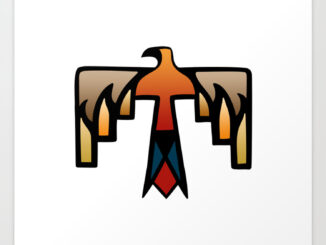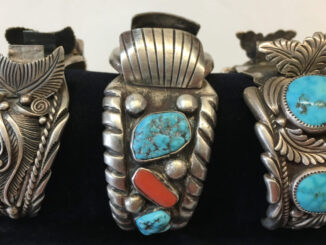
“Everyone is an artist. You’ve been given a gift of seeing (and hearing since it’s not just visual) in a certain way. The trick is letting it out” internationally-acclaimed performance artist James Luna assured his crowd of listener’s at Friday’s gallery talk on the University of Southern Maine campus. Standing amid the Turtle/Television Island Project installed at the University of Southern Maine Art Gallery and curated by Carolyn Eyler, Luna shared the behind-the-scenes stories, the life histories if you will, of each of the pieces on display, many of which are used as elements in his performance installations.
Luna, a member of the Puyoukitchum (Luiseño) tribe based in La Jolla, California, shared that “People come in thinking ‘I’m going to see Indian art. Horses. Feathers. Bark. I hear he’s gonna dance.’ I’m not any of that. I’m breaking perceptions. But I’m not just talking about me and other Indians, but humanistic things, how we relate to one another. We need to understand our similarities more than our differences and then maybe there will be peace in our lifetime. Art can do that.”
Well, at least Luna’s art can.
Luna is known for challenging his audiences by puncturing their expectations about what an “Indian” is or how one should look or act or even how “Indian art” should appear. As I wrote in another post on my Heritage in Maine blog, the first time Luna came to my attention was in the early 90s when I heard about his jaw-dropping performance installation called “Artifact Piece.” In a brilliant critique of longstanding museum practices of exhibiting Native American bodies or burials in gallery displays, Luna clad in only a breech cloth, installed himself in a glass case at the San Diego Museum of Man.
The theme of commercialization and exploitation of Native American spirituality is evident in one of the notable pieces on display. “Wet Dream Catcher” (photo on blog) is a condom- and good-luck-charm-adorned tennis racket that parodies the ubiquitous dream catchers for sale in stores which, in turn, mimic the spiritual item known as a “dream catcher.” Luna explained that “Wet Dream Catcher” expresses his frustration with the selling of Native American spiritual items. “It’s not stuff to sell. If you take, you have to give back.”
All of Luna’s pieces ricochet between popular culture expectations of Indianness and elements of both historical and contemporary Indian experience.
The Turtle/Television Island Project installation is shared with the only Penobscot woman birchbark artist, ssipsis, who is also a poet and activist. The installation includes stunning birchbark artwork on loan from Maine’s Hudson Museum and Abbe Museum, and from ssipsis, as well as a section of a birchbark longhouse, constructed by Barry Dana (Penobscot). Subsequent events in November will feature and discuss ssipsis’ work which is available to visitors to the USM Art Gallery.
Unless otherwise stated, PONIREVO and/or its licensors DO NOT own any intellectual property rights in the website and material on the website. Majority of the site’s content has been scraped and auto posted by a third party artificial intelligence program —– PONIREVO Creation Team.
Proudly WWW.PONIREVO.COM



